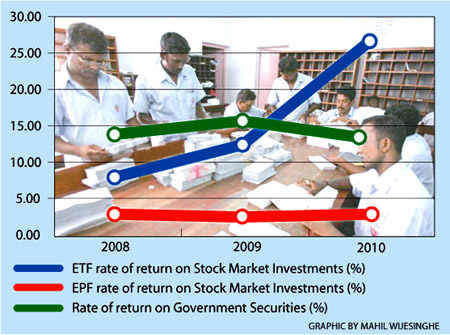|
EPF equity investments bring low returns:
ETF on a better footing

ETF has made a return of 26 percent on equity investments while EPF
returns stand below 4 percent an Analysis by Verité Research shows that
Employee’s Provident Fund’s (EPF)management of equity investments have
made low returns in comparison to stock market growth for the
corresponding period and in comparison to returns made by the Employees
Trust Fund (ETF).
EPF’s investments in the stock exchange has underperformed the All
Share Price Index (ASPI), and earned only one-fourth of what it would
have earned if the same investment had been placed with the usual
no-risk-low-return government securities, where 95percent of the EPF
funds are placed.
The investment of the EPF funds is under the supervision of the
Monetary Board of the Central Bank.
Historically, the main investments by the Fund have been in
Government Securities. This is not without its problems as the EPF has
been used as a cheap source of borrowing for the government, at the
expense of reasonable returns for the workers.
A study by the Institute of Policy Studies titled “Designing
Retirement-Income-Security Arrangements:
Theory, Issues and Applications to Sri Lanka” (de Mel, 2000)showed
that the EPF returns had been negative in real terms over a workers
career.In 2009, the Monetary Board invested 97.1 percent of the EPF Fund
in Government Securities, with a return of 15.70percent, while in 2010,
it invested 94.1percent with a return of 14.60 percent. At the same time
there was a move to increase the investment in the stock exchange.
In 2009, only 1.3% of the Fund (Rs.9.8 billion), was invested in
equities; but in 2010, there was a four-fold increase with 5% of the
fund (Rs.43.7 billion) being invested in equities.
The Central Bank has explained this increased investment in equities
on the basis that there was a need to diversify investments as returns
to government securities were on the decline. The explanation, however,
is contradicted by the outcome: the return to the EPF’s investment in
equities in 2009 was 3.53percent and in 2010 it was 3.81percent.
If the same investments had been kept in short and long term
government securities at the average yield, the EPF would have earned
almost 4 times as much it did by investing in equities. In 2009 post
civil war, the Sri Lankan stock exchange boomed, and in 2010 it became
the best performing stock exchange in the world. The percentage increase
of the ASPI in these two years was 125percent and96percent. In that
light, how the EPF managed to garner returns of just 3.53percent and
3.81 percentis puzzling in the extreme, and should require a public
accounting.
The Employees Trust Fund (ETF), which is managed by the Commissioner
of Labour, has also made investments in equities. In contrast to the
EPF’s return of 3.81percent the ETF made a return of 26percent on their
investment in 2010.The loss to workers as a result of mismanagement of
the fund’s investments in equities can be calculated at Rs. 71.2 billion
in 2010 alone. More than the absolute amount, the scale of loss is a
cause of concern. Where the quantum of investment had an expected market
return 73.9 billion based on the ASPI of the stock exchange in 2010, the
EPF earned only 1.7 billion: an adverse ratio of 43:1 (that is, if EPF
had simply distributed its investment proportionately across all shares
in the stock market without any thought or analysis, it would have
earned 43 times more than it actually earned with its expert investment
decisions).
The stock market is what economists call a “constant sum game”.
That is,the total long term benefits available from the stock market
are equal to the actual increase in dividends fromthe underlying stocks.
All deviations from this underlying increase in value are “zero sum”:
that is, one person’s loss is another person’s gain. Therefore, the huge
underperformance of the EFP investment is not without beneficiaries. |

